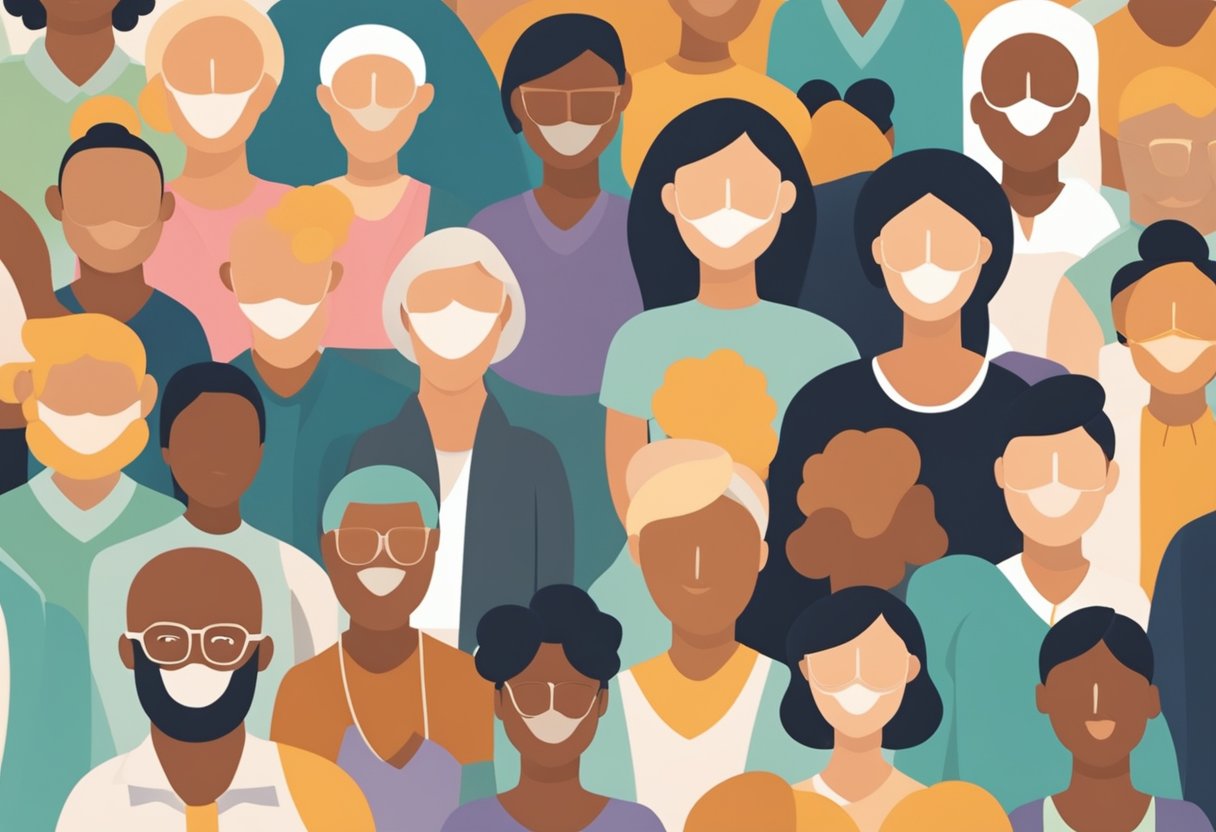Navigating Health and Work-Life Balance for Survivors
Surviving cancer is akin to being given a second chance at life.
After battling and surviving lymphoma cancer twice, we’re greeted with a new set of challenges and a profound perspective that reshapes our everyday lives.

We enter a phase of survivorship, a term that signifies the complex journey after cancer treatment.
As survivors, we must prioritize our well-being, which often means striking a delicate balance between our work commitments and the need for rest and recovery.
Overworking can quickly become a trap, threatening the fragile equilibrium we strive to maintain.
We have learned through experience that living with cancer as a chronic condition requires vigilance and adaptive changes in various aspects of our lives.
For us men who have been through the grueling journey of cancer, it’s particularly significant to advocate for our health and embrace strategies that contribute to long-term well-being.
From tapping into support networks to engaging in regular physical activities aligned with our passions, we can fortify our resilience and enhance our quality of life.
Key Takeaways
- Survivorship calls for a balance between work and essential self-care.
- Regular physical activity and community support bolster resilience.
- Vigilance and adaptive lifestyle changes are key to long-term well-being.
Understanding Cancer and Survivorship

In examining the landscape of cancer, we must recognize not just the disease’s nuances but the resilience and ongoing needs of those who survive it.
Defining Cancer and its Types
Cancer is a group of diseases in which abnormal cells proliferate beyond normal boundaries, often invading other body parts.
While there are more than 100 types of cancer, some of the more common ones we encounter include prostate cancer, lymphoma, colorectal cancer, and skin cancer.
Our experiences can vary significantly depending on the type we face—certain kinds may be more responsive to treatment than others.
The Journey of a Cancer Survivor
Survival extends beyond the physical eradication of cancer from our bodies. It encompasses our recovery and adaptation post-treatment.
This means managing lingering symptoms and monitoring for signs of recurrence.
As survivors, we stride toward a new equilibrium, where we balance life’s responsibilities with our health, structure our days around recovery, and provide support to fellow survivors.
Overview of Cancer Treatment Modalities
Treatment options for cancer typically involve one or a combination of three primary modalities: chemotherapy, radiation therapy, and surgery.
Chemotherapy uses medication to destroy cancer cells, radiation therapy employs high doses of radiation to target cancer cells, and surgery aims to remove cancer physically.
Each of us may require different treatment plans based on the stage of our cancer, whether it’s early-stage or more advanced, and our overall health.
Physical and Emotional Effects

Our journey as cancer survivors exposes us to an array of physical challenges and emotional hurdles.
We grow stronger when we recognize and address these aspects with care, patience, and support.
Late- and Long-Term Physical Effects
The road to recovery isn’t just about overcoming the initial illness; it’s also grappling with late effects that can manifest well after treatment ends.
Many of us experience fatigue that makes even the simplest tasks feel strenuous. We must listen to our bodies and rest as needed.
Regular exercise like swimming or walking can help manage exhaustion and maintain vitality.
Pain is another reality for many, varying in intensity and duration.
Solutions may include physical therapy to relieve discomfort or relaxation techniques like yoga to ease muscle tension.
It’s not just about managing symptoms but seeking lifestyles that support our well-being.
Emotional and Psychological Challenges
Beyond the physical, we cope with complex emotions that include but aren’t limited to anxiety, depression, and a profound fear of recurrence.
It’s natural for us to wrestle with the thought of cancer recurrence.
Creating a robust support network and engaging in regular discussions with our healthcare providers can offer reassurance and strategies for coping.
Mental health maintenance is as crucial as physical health.
Some find solace in counseling or support groups where we can share our experiences and strategies for finding peace.
Others may turn to meditation or mindfulness practices to fortify their emotional resilience.
We are not alone; tapping into our collective strength allows us to navigate these emotional waves with greater steadiness and community support.
Living with Cancer as a Chronic Condition

Living with cancer as a chronic condition entails a continuous journey of management and adaptation.
This path requires a commitment to understanding and addressing the intricacies of ongoing symptoms and embracing a lifestyle that accommodates the unique needs of long-term survivorship.
Managing Ongoing Symptoms
We recognize that managing ongoing symptoms is not a straight line.
Treatments often result in lingering effects such as fatigue, lung problems, or lymphedema.
To alleviate these, we focus on three key areas: sleep, nutrition, and exercise.
- Sleep: Aim for 7-9 hours per night; establish a regular schedule.
- Nutrition: Consume a balanced diet with an emphasis on whole foods.
- Exercise: Engage in sports and activities that boost cardiovascular health and strength.
Adapting to a New Normal
After facing lymphoma, we’ve learned that adaptation is a continuous process.
We weave new routines into our life tapestry that reflect our altered physical abilities, embracing activities such as swimming or cycling, which are gentle on the body yet foster endurance and resilience.
Our experience has taught us that during and after treatment, our bodies and minds seek stability.
Setting achievable goals within a community of fellow survivors fosters a sense of accomplishment and mutual support.
- Community: Find a support group of men who encourage and understand each other.
- Goals: Set realistic targets that motivate us to stay active without overexerting ourselves.
Strategies for Health and Well-Being

As cancer survivors, we have a unique road ahead of us, blending the necessity of comprehensive care with the adoption of healthier lifestyle habits.
Importance of Follow-Up Care
Routine check-ins: These are the cornerstone of our long-term wellness.
By adhering to a schedule of follow-up appointments, we ensure any changes in our health are promptly addressed.
This proactive step allows for early intervention, if necessary, contributing positively to our overall well-being.
Treatment Adjustments: It’s not uncommon for us to undergo various treatments, like immunotherapy or hormone therapy.
It is vital to continuously review such therapies during follow-up visits. They help tailor treatment plans to fit changing needs and support our bodies’ healing process.
Lifestyle Changes and Self-Care
Exercise: Physical activity is a proven way to bolster our health.
Incorporating tailored exercises into our routine helps us maintain strength and improves our quality of life.
Nutrition and Sleep: Embracing a healthy diet nourishes our bodies, while quality sleep gives us the rest we need.
Both are pillars of self-care that we cannot afford to overlook.
Psychosocial Support and Therapy
Support Networks: Joining support groups allows us to share experiences and receive encouragement.
We gain strength knowing we’re not alone in this.
Stress Management: Techniques such as mindfulness, yoga, and other stress-reducing practices can provide substantial relief and improve mental well-being.
The Psychosocial Health Needs of survivors like us should be met with appropriate coping strategies, making therapy a valuable tool for emotional strength.
Special Considerations for Different Populations

Our journey through cancer and its consequent survival teaches us the necessity of tailoring recovery to each survivor’s unique circumstances. We recognize different groups’ diverse challenges as they re-engage with life’s routines.
Childhood Cancer Survivors
For us who endured cancer battles as children, the road to recapturing a sense of normalcy is layered with distinct challenges.
Integrating into educational settings demands a thoughtful approach to accommodating our educational and emotional needs. Our physical development must be closely monitored to preempt and manage late effects, ensuring our growth mirrors our peers.
- Educational Adjustments: Tailored tutoring, flexible scheduling
- Emotional Support: Counseling services, peer support groups
- Physical Development: Regular health assessments, modified sports activities
We strive to champion these adjustments with steadfast determination to ensure our academic success and the joy of participating in sports with classmates, nurturing an identity beyond our survivor status.
Cancer in the Workplace
Entering or returning to the workplace as a cancer survivor ushers in a series of considerations centered on our continued well-being.
Our careers must allow regular health evaluations and time off for necessary rest. We strive to secure employment that sustains us financially and affirms our values and abilities within a supportive environment.
- Workplace Adjustments: Adaptive workstations, flexible hours
- Income Protection: Employment insurance plans, financial counseling
- Health Prioritization: Access to medical leave, wellness programs
We combine experience from our battles with lymphoma to guide fellow male survivors in navigating employment.
By actively engaging in work that validates our strengths and accommodates our health needs, we foster a culture of understanding and empathy within professional spheres.
Preventive Measures and Monitoring
As we navigate life after cancer, our focus shifts to proactive strategies and vigilant oversight. We prioritize our health to mitigate risks and stay ahead of any potential complications from our past battles with lymphoma.
Cancer Screening and Prevention
Routine screening is our first line of defense. Depending on the stage of diagnosis and type of treatment we’ve undergone, our healthcare team recommends personalized check-up schedules.
Screening tests, including blood work and imaging scans, become necessary. Here are a few guidelines we always consider:
- Clinical Trials: Innovative approaches can be beneficial. We keep informed about trials offering new ways to detect early cancer signs.
- Tobacco: Those of us who have smoked quit as soon as we understood the risk it poses, not just for lung cancer but all types.
Monitoring for Recurrence or Secondary Cancers
Our journey with lymphoma taught us vigilance. We maintain close contact with our care team for thorough follow-up care. Here’s how we stay on top of our health:
- Regular Appointments: We follow a structured follow-up schedule, ensuring no anomaly goes unnoticed.
- Understanding Staging: We know our cancer stage, as it informs our monitoring frequency and intensity.
- Physical Activity: Engaging in sports helps us stay fit and monitor our body’s response to exercise for unusual symptoms.
By adopting these practices, we strengthen our defense against cancer recurrence and the appearance of second cancers.
Resources and Support
We’ve all fought brutal battles against cancer and understand the need for robust support networks and reliable resources. It’s crucial we find strength in unity and shared knowledge to ease our journey post-cancer.
Accessing Help and Resources
Seeking out help paves the path to a balanced life after cancer.
We can tap into a wealth of information and resources the American Cancer Society provides that address our needs, ranging from cancer care to maintaining our identity as survivors.
Local clinics and hospitals often offer survivorship programs for personalized care, ensuring we receive tailored health plans and educational material that aid our long-term recovery.
- Treatment Summaries: Secure copies of our treatment details, as this information is fundamental for ongoing care.
- Healthcare Professional Guidance: Regular check-ins allow us to address concerns promptly with a healthcare team experienced in cancer aftermath.
- Education: Knowledge about potential long-term and late effects empowers us to advocate effectively for our health.
Community and Online Support Networks
Connecting with peers is vital; shared experiences foster deep bonds and communal healing.
Engaging with support groups offers us camaraderie and understanding unique to fellow survivors.
Additionally, we can join the Cancer Survivors Network to interact with others who have faced similar challenges.
- Local Meetups: Interaction with nearby survivor communities for mutual support in person.
- Online Forums: Participation in virtual discussions for various insights and emotional backing from survivors worldwide.
Final Thoughts
As fellow cancer thrivers and advocates for holistic well-being, we comprehend the allure of burying ourselves in work after enduring something as life-altering as cancer.
It’s a common strategy, but we also recognize the necessity of balance. For us men who have triumphed over lymphoma not once but twice, the journey taught us invaluable lessons about prioritizing our health and embracing rest.
Self-care is no buzzword in our community; it’s the cornerstone of sustained recovery.
We carve out time for activities that refill our inner reserves—a quiet morning walk, an exhilarating cycle, or the supportive camaraderie on the basketball court.
Personal growth emerges from these moments of tranquility and play.
We also tap into a profound resilience that fuels our triumphs off the court by staying present. -T
We encourage our brothers in healing to engage in these restorative practices:
- Mindful movement: Gentle stretches or yoga to maintain flexibility
- Team sports: Joining a local league to foster a sense of belonging
- Reflective time: Journaling or meditative practices to process experiences
Frequently Asked Questions
As survivors, we often navigate the complexities of reintegrating into our professional lives. Here’s what we typically inquire about as we do so.
What are the typical work accommodations made for individuals recovering from cancer?
Employers may offer flexible hours, part-time schedules, or the option to work from home.
Physical changes like ergonomic office furniture also help us stay comfortable during extended work periods.
How does returning to work after cancer treatment affect an individual’s mental health?
Re-entering the workforce can bring mixed emotions: a sense of normalcy and routine on one hand and stress or anxiety on the other.
Having a supportive network and access to mental health resources is crucial.
What legal protections are in place to prevent the termination of employment due to cancer diagnosis?
Laws like the Americans with Disabilities Act and the Family and Medical Leave Act provide job security, ensuring we’re not unfairly dismissed due to our health history.
What support systems should employers have for employees who are cancer survivors?
A sound support system includes resources such as employee assistance programs, access to counselors, and peer support groups.
Affirmation from colleagues offers us extra strength in our day-to-day tasks.
How often do cancer survivors face discrimination in the workplace?
Despite legal safeguards, discrimination persists.
We may encounter biases that impact promotions or job responsibilities, which calls for diligent awareness and a proactive stance against such injustices.
In what ways can overcoming cancer influence a person’s approach to their career and work-life balance?
Having faced a formidable challenge, we often reassess our priorities. We strive for rewarding careers that align with healthy work-life harmony.
